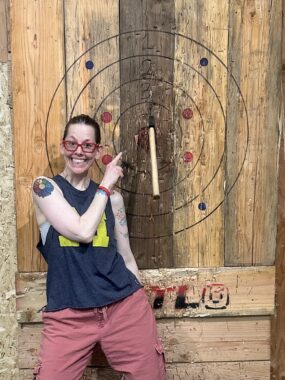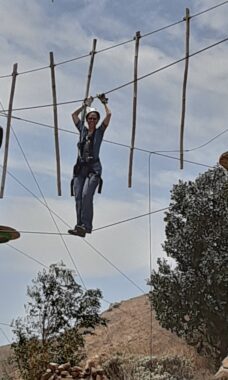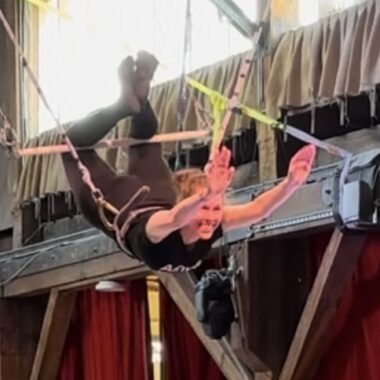Flying through the air, even with hemophilia
How I've found ways to safely participate in thrilling activities

The song “The Daring Young Man on the Flying Trapeze,” lyrics by George Leybourne and music by Gaston Lyle, plays loudly in my mind. As a child, I loved the lines “He’d fly through the air with the greatest of ease/ That daring young man on the flying trapeze.” (Other versions of these lyrics exist, but these are the original.)

G Shellye Horowitz loves the safe thrill of ax throwing. (Courtesy of G Shellye Horowitz)
In elementary school I had a swing set with a swing on one side and a metal trapeze on the other. One day I sat on the swing and kicked my legs back and forth, swinging as high as I could. At the perfect moment I hurled myself off the swing and through the air, reaching for the trapeze. My hands missed, and I landed on my back and head. I blacked out, and when I woke up I couldn’t see straight. I screamed bloody murder.
Given that I have hemophilia, it’s nothing short of a miracle that I came away with only a few scratches and a concussion. I didn’t even break a bone. I cannot tell you how bruised I was, as I couldn’t see the area that took the brunt of the landing.
I’ve always wanted to fly, dance, perform, and play sports. I yearned to run fast and free with the wind on my face. But growing up with undiagnosed hemophilia A limited me.
In school I wanted to be good at sports, but it hurt every time I ran. I was called “lazy” by teachers, classmates, and even my doctors. I was accused of faking pain to get out of participating. They didn’t understand how badly I wanted to be able to keep up.
Learning my boundaries

G Shellye tackles an aerial ropes course. (Courtesy of G Shellye Horowitz)
My life is a constant test of what I can and cannot do. I’ve had to learn my limits and find activities that are fulfilling and fun (and a bit thrilling). Simultaneously, I must be astutely aware of my limitations. Knowing my own strengths and weaknesses helps me decide which activities I can participate in. When needed, I consult my hemophilia treatment center team for advice. They offer input to keep me as safe as possible.
There’s a list of activities I’ve either been unsuccessful at or don’t want to try because they feel too dangerous for me. I’ve chosen never to downhill ski or skydive. I tried running, but pounding my feet on the hard pavement quickly proved too rough for my ankles and knees. Contact sports have also been challenging. In third grade I was playing Ultimate Frisbee and took a strong Frisbee hit directly to my neck. I never played that again.
But there are many things I can do, as long as I’m careful and don’t push myself too hard. It’s critical for me to avoid injury and protect myself with factor replacement products.
Dance has been a part of my entire life. I’ve progressed with tap and international folk dance, improving my skills slowly. I was a competitive swimmer for years, competing in butterfly, backstroke, freestyle, and individual and group medleys. I love to ride bicycles outdoors, as well as use an indoor recumbent bike. Hiking is great way to explore the gorgeous trails in the majestic Redwood forests here in Northern California. It’s breathtaking.
Safely thrill seeking

The daring G Shellye soars on the flying trapeze. (Courtesy of G Shellye Horowitz)
Discovering ways to engage in thrill-seeking activities while remaining safe is a gift. I throw axes! Zip lining helps me capture the feeling of flying through the air. Aerial ropes courses are also a lot of fun. Can you imagine tackling obstacles 100 to 300 feet in the air? A safety cord affords me this high-adrenaline experience without great risk of harm.
Finding ways to participate in thrilling activities as a person with hemophilia brings me great joy. I know I can’t do everything I may want to do. I’ll never run a marathon, for instance. Yet there are so many things I can do.
This fills me with incredible gratitude for the hematologist who listened, believed me, and helped me get the care I needed. I’m also thankful for my team of physical therapists, nurses, a social worker, a genetic counselor, and doctors who develop and adapt plans to keep me healthy and safe.
Sometimes life surprises us with a second chance, and I was thrilled to rewrite Leybourne’s lyrics last summer: “She flew through the air with the greatest of ease,/ That daring Shellye on the flying trapeze.”
At a proper circus training school with two coaches and a safety belt, I climbed up to the platform, grabbed hold of the bar with two hands, and jumped. Indeed, I flew through the air on a flying trapeze — protected. When I was finished, I landed with grace on the net below. My smile lasted for weeks. I can’t wait to fly again.
Note: Hemophilia News Today is strictly a news and information website about the disease. It does not provide medical advice, diagnosis, or treatment. This content is not intended to be a substitute for professional medical advice, diagnosis, or treatment. Always seek the advice of your physician or another qualified health provider with any questions you may have regarding a medical condition. Never disregard professional medical advice or delay in seeking it because of something you have read on this website. The opinions expressed in this column are not those of Hemophilia News Today or its parent company, Bionews, and are intended to spark discussion about issues pertaining to hemophilia.








Leave a comment
Fill in the required fields to post. Your email address will not be published.